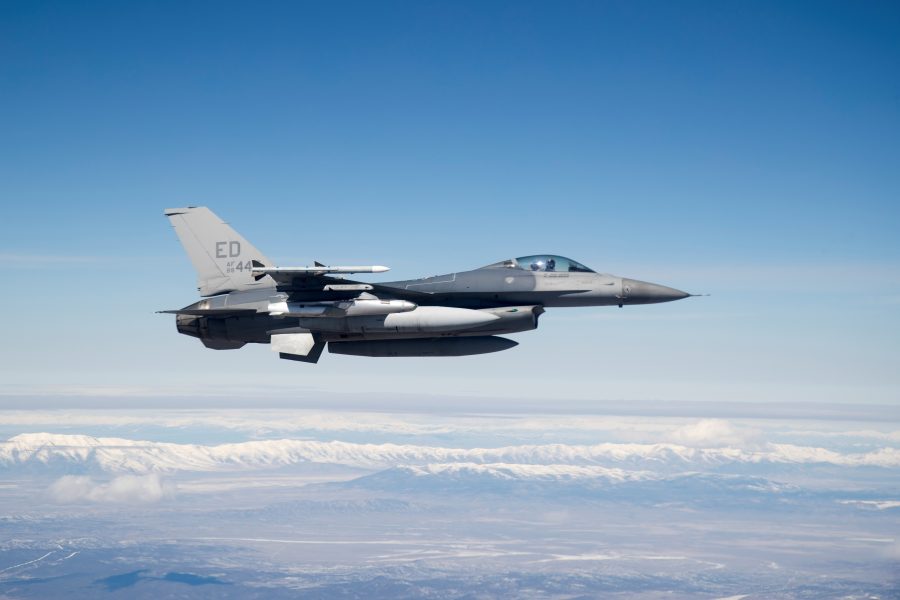Three F-16 fighters landed at Eglin Air Force Base, Fla., on April 1. Soon enough, they’ll be modified and flying again to test autonomous technologies key to Collaborative Combat Aircraft and other key programs, the Air Force said April 2.
The plan is to convert six F-16s under the Viper Experimentation and Next-gen Operations Model – Autonomy Flying Testbed program, or VENOM-AFT. Maj. Ross Elder, VENOM developmental test lead at Eglin, said that the program marks a “pivotal chapter” in the aerial combat advancements.
“This transformative program holds the potential to redefine air combat paradigms by fostering novel autonomous functions for current and future crewed and uncrewed platforms,” Elder said in a release. “We look forward to the culmination of years of engineering and collaboration, as VENOM leads a measured step towards a new age of aviation.”
VENOM first came to light last year, when the Air Force requested nearly $50 million for it in the fiscal 2024 budget and officials detailed their hopes for it. In the 2025 budget, the service is seeking just under $17 million for the effort, the latest in a string of programs meant to test autonomous capabilities. Skyborg, led by the Air Force Research Laboratory, developed aircraft-agnostic autonomous flight software, and the X-62 VISTA was a modified F-16 used to explore maneuvering and tactics of autonomous aircraft, able to simulate the behavior of various designs.
VENOM will take the next step in trying to rapidly expand the service’s knowledge base about autonomy, to ultimately speed up the development of Collaborative Combat Aircraft (CCA), which will integrate unmanned drones with manned platforms.
“With regards to VENOM-AFT, rapid tactical autonomy development focuses on ‘speed-to-ramp,’ meaning, go as fast as you can, safely, to ensure we get CCA flying as quickly as possible,” said Lt. Col. Joe Gagnon, 85th Test and Evaluation Squadron commander of the 53rd Wing at Eglin.
The Air Force plans to build at least 1,000 CCAs, with the first ones ready for combat in 2028. Earlier this year, the service selected five companies for the project, of which only two or three will receive follow-on contracts in the next months.
CCAs will play a crucial part in the Air Force’s planned Next Generation Air Dominance “family of systems” centered around a manned fighter. The service plans to dramatically ramp up its investment in NGAD and CCAs in the coming years, allocating $28.48 billion for fiscal 2025-29. Experts have described CCAs as central for the service’s plan to deter conflict and impose costs on a high-level adversary like China. These uncrewed systems could act as force multipliers, enhancing sensor and weapon deployment in contested regions and bolstering the effectiveness and survivability of crewed stealth aircraft.
Upon modification, the VENOM F-16s will undergo developmental and operational testing at Eglin under a collaborative effort led by the 96th Test Wing and 53rd Wing.
“Having both developmental test and operational test pilots working and flying from the same location allows for daily collaboration and reduces the stove piping of knowledge and lessons learned,” said Lt. Col. Jeremy Castor, VENOM operational test lead.
During these tests, pilots will still sit in the cockpit to monitor autonomy functions, while operators will provide feedback during modeling, simulation, and post-flight to the developers to ensure flight objectives are met prior to and during flight. Gagnon stressed “there will never be a time these VENOM aircraft will solely fly by itself” without someone present.
“It’s important to understand the ‘human-on-the-loop’ aspect of this type of testing, meaning that a pilot will be involved in the autonomy in real time and maintain the ability to start and stop specific algorithms,” said Gagnon.
VENOM is also a part of Eglin’s on-going project called Autonomy, Data, and AI Experimentation (ADAx) that is pushing the limit of autonomous capabilities. Last year, Eglin witnessed the maiden autonomous flight of the Osprey MK III unmanned aerial system under ADAx. Like VENOM, a human operator oversaw the aircraft’s autonomous operation within designated airspace during the MKIII test flights.
